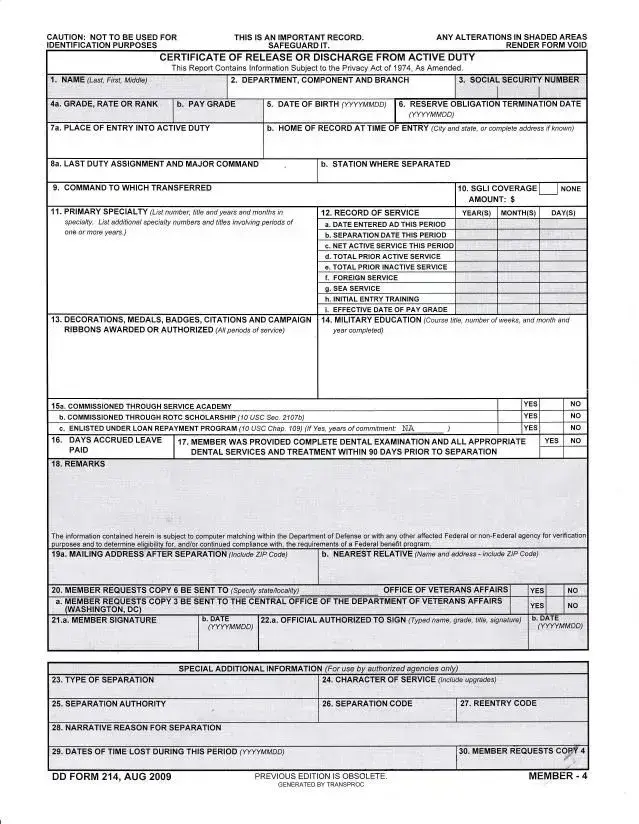Instructions on Utilizing Dd 214
Filling out the DD Form 214 is an important step for service members. This document will be used for various purposes, such as applying for benefits or demonstrating military service. Proper completion ensures all vital information is accurately recorded and helps in safeguarding your military records.
- Begin with Personal Information: Fill in your name, ensuring to use your first name and last name correctly.
- Department, Component, and Branch: Identify the specific military department, component, and branch you served in.
- Social Security Number: Provide your Social Security number in the designated space.
- Grade, Rate, or Rank: Indicate your military rank at the time of discharge.
- Pay Grade: Enter your pay grade at separation.
- Date of Birth: Write your birth date in the format YYYYMMDD.
- Reserve Obligation Termination Date: Fill in the last day of your reserve obligation, if applicable.
- Place of Entry into Active Duty: Document where you entered active duty.
- Last Duty Assignment and Major Command: List your last duty assignment along with the major command under which you served.
- Command to which Transferred: Fill in the name of the command you were transferred to, if applicable.
- Home of Record at Time of Entry: Indicate the home address on file at the time of entry into service.
- Military Specialty: Specify your military occupational specialty.
- Decorations, Medals, Badges, Citations: List any awards or decorations you received during your service.
- Station Where Separated: Fill in the location where you were discharged.
- SGLI Coverage: Indicate if you had Servicemembers’ Group Life Insurance and the coverage amount.
- Record of Service: Provide the dates for your service period, including entry and separation dates.
- Net Active Service This Period: Calculate your net active service days for this period.
- Total Prior Active Service: Confirm your total prior active service time.
- Foreign Service: List any time you served overseas.
- Sea Service: Note any time spent in service at sea.
- Initial Entry Training: Document the time spent in initial training.
- Effective Date of Pay Grade: Fill in when your pay grade became effective.
- Military Education: List any military training and education.
- Commissioned Through Service Academy: Mark yes or no regarding commission through a service academy.
- Days Accrued Leave: Provide any leave days accrued during your service.
- Dental Examination: Indicate whether you were provided a complete dental examination prior to separation.
- Mailing Address After Separation: Complete your mailing address for correspondence after discharge.
- Request Copies: Specify if you want copies sent to various offices as listed.
- Signature and Dates: Sign the form and date it in the designated sections.
- Additional Information: If applicable, fill in any special additional information as needed.
- Type and Reason for Separation: Indicate the type and authority of your separation and the narrative reason.
- Character of Service: Provide a characterization of your service.
- Separation Code: Fill in the separation code corresponding to your discharge.
- Reentry Code: Indicate your assigned reentry code.
Carefully review each section for accuracy before submitting your DD Form 214. Having this record prepared correctly is essential for obtaining benefits and ensuring that your military service is properly documented.
